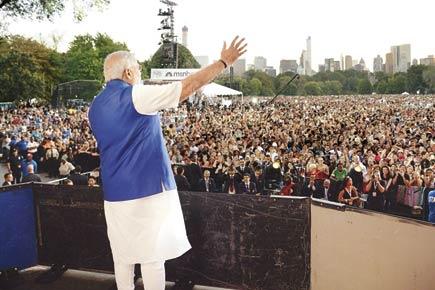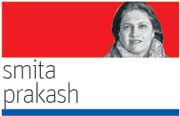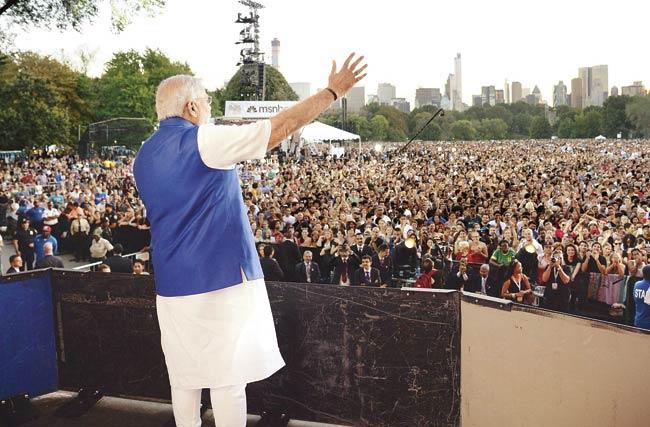I first covered an Indian Prime Minister at the UN when Atal Bihari Vajpayee was the prime minister in the early 2000s and nobody gave a rat’s posterior of what an Indian PM had to say at the UN

 I first covered an Indian Prime Minister at the UN when Atal Bihari Vajpayee was the prime minister in the early 2000s and nobody gave a rat’s posterior of what an Indian PM had to say at the UN. Being part of the Indian media contingent, one could only hope for a passing mention of the Indian PM. And hopefully not hyphenated with Pakistan or Kashmir crisis. But even that was ambitious. In contrast Pakistan’s President General Musharraf was all over the place. He even managed to appear on Jay Leno’s show, which was huge.
I first covered an Indian Prime Minister at the UN when Atal Bihari Vajpayee was the prime minister in the early 2000s and nobody gave a rat’s posterior of what an Indian PM had to say at the UN. Being part of the Indian media contingent, one could only hope for a passing mention of the Indian PM. And hopefully not hyphenated with Pakistan or Kashmir crisis. But even that was ambitious. In contrast Pakistan’s President General Musharraf was all over the place. He even managed to appear on Jay Leno’s show, which was huge.

Reams and reams have now been written on the meetings that PM Modi had in the five days in New York and Washington DC, the CEOs that he met, the presidents and prime ministers he interacted with, and common people of Indian origin. To each he promised a new India. Pic/Getty Images
ADVERTISEMENT
By the last year of his primeministership, Mr Vajpayee could neither see nor walk properly. He was forgetful, would mistake names of his ministers and the Indian ambassador, his speeches were laborious but we dutifully ignored all this. There was an unsaid accord among journalists not to expose the frailties of the prime minister. He was genuinely liked and we were sad to see him wither away. One America-based Indian journalist in 2002 astutely but harshly remarked, “ABV is a myth created by the BJP and propagated by the media."
The BJP lost the 2004 election and Dr Manmohan Singh became prime minister. His resume could put any academic to shame. He was the most educated among all world leaders. Dr Singh was a well-respected figure in his first term but in New York at the UNGA, he was still not a newsmaker. World leaders would make a beeline to Dr Singh to consult him on things like Euro crisis or the possibility of second-generation reforms in India but not the media.
Covering the Indian Prime Minister at the UN suddenly gave one hope that the Indian story was going to be scripted before one’s eyes, even as Pakistans was crumbling. Pakistani journalists were barely around, their prime ministers and presidents were getting insecure and insignificant. State and non-state actors were securing Pakistan’s place as a pariah nation. And all this while, there was a build up about India. The world saw India as the new superpower in the making; the US had faith in India of the future, what could go wrong.
Well, it did. The second half of the second term of Prime Minister Singh undid all the careful construct of the eight years. India looked like a Banana Republic with crony capitalism at its zenith and Dr Singh looked tired and frustrated. For many of us who had looked upon the Singh years as the one which would catapult India on to the world stage, it was a massive comedown. For eight years, the Indian media was cheerleading when reporting from the UNGA and other international forums; now it was embarrassing. The prime minister and India itself looked tired and dispirited.
Another election, another prime minister. This time a bigger dream, a bigger promise, more hope. Prime Minister Modi was set to take New York by storm. His UN speech was going to be better than the ones of past prime ministers; his promise to the world was going to be on deliverables we were told. So media houses sent ‘all boots on the ground’. We were all there, breathlessly documenting a historic moment, with hyperbole, gusto, excitement, poetry, grandiose prose, music, drama and every communication tool we could muster up. This was an event not to be missed.
And foreign news networks including American media did not ignore the Indian Prime Minister. They covered the visit in New York and Washington DC, with humour, sarcasm, pragmatism and lucidity. Most importantly they did not ignore. And NRIs…. they came in thousands, dressed in all their traditional attire, singing dancing, raising slogans. Celebrating a new era. You cannot put them down as déclassé. As Iqbal said, Jamhooriat ek tarze-hukumat ha kay jisme bandon ko gina kartey hain, tola nahi karte (Democracy is a certain form of government in which men are counted, not weighed).
So reams and reams have now been written on the meetings that PM Modi had in the five days in New York and Washington DC, the CEOs that he met, the presidents and prime ministers he interacted with, and common people of Indian origin. To each he promised a new India, where they could be partners with us, us those who live in India. Sar Zameen-e-Hind par aqwaam-e-alam ke qafile guzarte gaye, Hindustan bantaa gaya, said Firaq (Caravans of people from all parts of the world kept passing through and India kept getting made).
Dare we hope a new construct is happening in India? Fate willing, I will be here again in New York next year, documenting whether in 2015 we achieved some of what was promised in 2014.
Smita Prakash is Editor, News at Asian News International. You can follow her on twitter @smitaprakash
 Subscribe today by clicking the link and stay updated with the latest news!" Click here!
Subscribe today by clicking the link and stay updated with the latest news!" Click here!







